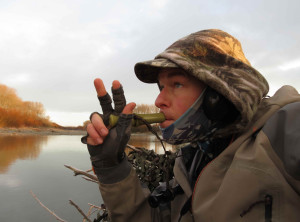If you're trying to lure birds to a particular spot, decoys will often help, as they encourage passing birds to think the area is safe.
Today’s decoys are well-priced, durable, light, well-coloured, and easily repaintable and repairable!
Exact colours are not important, but it is worth taking the shine off new decoys.
Shape and movement are important.
Correct layout and imparting movement to decoys will improve results no end!
Watch this video here for a quick how-to guide.
There are no hard and fast rules in setting out decoys, but here are some general guidelines you should consider:
- Space them apart a little so they are not touching – one metre apart is good
- Most decoys should face into wind, so tie the retaining cord to the front of the keel
- Decoy mooring lines should be at least 1½ times the deepest water depth
- Ducks will not land right among decoys. They will land outside of them so one option is to keep your decoys close to you. Alternatively, split your decoys into two groups with a clear water gap between
- Consider a stick as a range marker, or alternatively put your furthest decoys at 40 metres or a couple of drakes at 40 metres
- In many cases, and especially at the beginning of the season, the more the better. Twenty or so decoys for a pond of 1 hectare are adequate. But a few is better than none!
- Choose areas where ducks are likely to shelter; still water and sheltered areas
- Consider putting some decoys on the banks of the river or pond
- Decoy movement is important. There is a range of motorised decoys available for sale, but one useful technique is to tie a string to one or two well-anchored decoys leading back to your maimai. Give it a gentle tug to jiggle the decoys as passing birds fly over.
Calling
Mastering duck calls will improve your success rate significantly. Adequate calling is not difficult, but requires some practice. There's a very good chapter on calling on our 'Introduction to Duck Hunting' DVD. It is also worthwhile spending time listening to ducks and watching ducky behaviour outside the season – public duck ponds are excellent for tuning your ear to duck calls.
It is good to team up with another hunter who's a good caller and learn directly from them. As a beginner, don’t call too much. A few quacks will get their attention which is all you need. The more you blow, the more chance that a bum note will put them off.
There are four basic mallard calls: ‘hail’, ‘greeting’, ‘come back’ and ‘feeding’. Our DVD takes you through each. Avoid very harsh three-note calls given within one second with each quack ending on a high note; this is an alarm call.
Other game bird species respond to calling, especially parries and California quail, and different callers and notes are needed. There is a huge a range of callers on the market. Our best advice is to try them all in the shop, and pick the one that sounds best to you!
